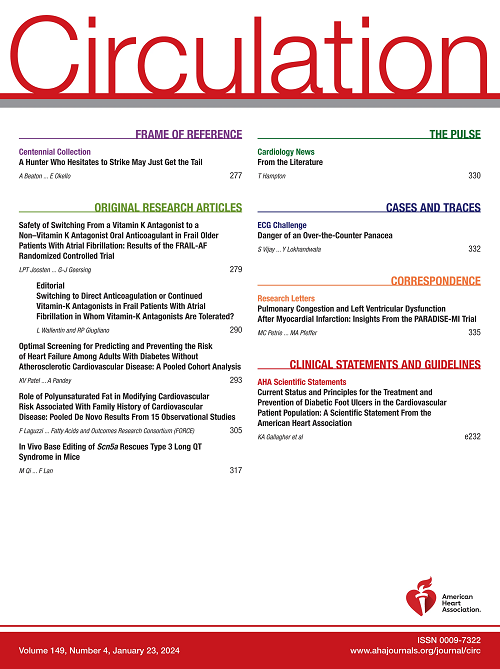Part 1: Executive Summary: 2025 American Heart Association Guidelines for Cardiopulmonary Resuscitation and Emergency Cardiovascular Care.
IF 38.6
1区 医学
Q1 CARDIAC & CARDIOVASCULAR SYSTEMS
引用次数: 0
Abstract
This executive summary provides an overview of the 2025 American Heart Association Guidelines for Cardiopulmonary Resuscitation and Emergency Cardiovascular Care, which is organized around the Utstein Formula for Survival and provides updated recommendations aimed at improving survival rates and neurological outcomes following cardiac arrest. This executive summary outlines key changes, emphasizing the importance of high-quality chest compressions, early defibrillation, and the integration of advanced resuscitation techniques. These Guidelines also highlight critical post-cardiac arrest care strategies, including targeted temperature management and hemodynamic stabilization. Additionally, they stress the need for population-specific resuscitation approaches, particularly for pediatric patients, pregnant individuals, and individuals with cardiac arrest due to special circumstances. A strong focus is placed on continuous training and education for both medical professionals and lay rescuers to enhance the implementation and effectiveness of these lifesaving interventions. The 2025 Guidelines also highlight the importance of an integrated system of people, protocols, policies, and resources to achieve quality improvement in cardiac arrest care. An overview of ethical considerations relevant to emergency cardiovascular care, resuscitation, and approaches to decision-making surrounding cardiac arrest is also included. By following these updated recommendations, the American Heart Association seeks to optimize resuscitation efforts and improve patient outcomes in cardiac emergencies.第1部分:执行摘要:2025年美国心脏协会心肺复苏和紧急心血管护理指南。
本执行摘要概述了2025年美国心脏协会心肺复苏和紧急心血管护理指南,该指南是围绕Utstein生存公式组织的,并提供了旨在提高心脏骤停后存活率和神经系统预后的最新建议。本执行摘要概述了关键变化,强调高质量胸外按压、早期除颤和先进复苏技术整合的重要性。这些指南还强调了关键的心脏骤停后护理策略,包括有针对性的温度管理和血流动力学稳定。此外,他们强调需要针对特定人群的复苏方法,特别是对儿科患者、孕妇和因特殊情况导致心脏骤停的个体。重点是对医疗专业人员和非专业救援人员进行持续培训和教育,以加强这些挽救生命的干预措施的实施和有效性。《2025年指南》还强调了人员、协议、政策和资源的综合系统对于提高心脏骤停护理质量的重要性。还包括与紧急心血管护理、复苏和围绕心脏骤停的决策方法相关的伦理考虑的概述。通过遵循这些更新的建议,美国心脏协会寻求优化复苏工作,改善心脏紧急情况下患者的预后。
本文章由计算机程序翻译,如有差异,请以英文原文为准。
求助全文
约1分钟内获得全文
求助全文
来源期刊

Circulation
医学-外周血管病
CiteScore
45.70
自引率
2.10%
发文量
1473
审稿时长
2 months
期刊介绍:
Circulation is a platform that publishes a diverse range of content related to cardiovascular health and disease. This includes original research manuscripts, review articles, and other contributions spanning observational studies, clinical trials, epidemiology, health services, outcomes studies, and advancements in basic and translational research. The journal serves as a vital resource for professionals and researchers in the field of cardiovascular health, providing a comprehensive platform for disseminating knowledge and fostering advancements in the understanding and management of cardiovascular issues.
 求助内容:
求助内容: 应助结果提醒方式:
应助结果提醒方式:


